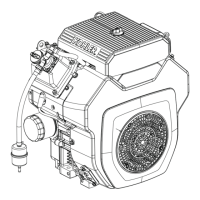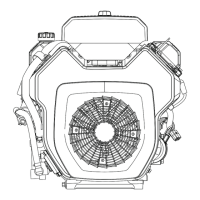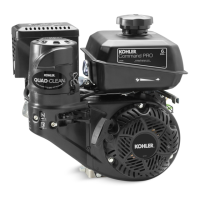Governor Cross Shaft Oil Seal
Cross Shaft Oil Seal Details
B
A
A 2.0 mm (0.0787 in.)
B Governor Cross Shaft Seal
If governor cross shaft seal is damaged and/or leaks,
replace it using these following procedures.
Remove oil seal from crankcase and replace it with a
new one. Install new seal to depth shown using a seal
installer.
Remove Connecting Rods with Pistons and Rings
NOTE: If a carbon ridge is present at top of either
cylinder bore, use a ridge reamer tool to remove
it before attempting to remove piston.
NOTE: Cylinders are numbered on crankcase. Use
numbers to mark each end cap, connecting rod
and piston for reassembly. Do not mix end caps
and connecting rods.
1. Remove screws securing closest connecting rod end
cap. Remove end cap.
2. Carefully remove connecting rod and piston
assembly from cylinder bore.
3. Repeat above procedure for other connecting rod
and piston assembly.
4. Remove piston pin from piston for inspection. Use a
small screwdriver to pry pin retainer out of groove.
Piston and Rings
Inspection
Piston and Rings Components and Details
Style A
A
B
C
D
F
E
Style B
C
B
A
E
D
A Piston B
Top Compression
Ring
C
Middle Compression
Ring
D Rails
E Expander F
Oil Control Ring
(3 Piece)
NOTE: Rings must be installed correctly. Ring
installation instructions are usually included with
new ring sets. Follow instructions carefully. Use
a piston ring expander to install rings. Install
bottom (oil control) ring fi rst and top
compression ring last.
Scuffi ng and scoring of pistons and cylinder walls occurs
when internal engine temperatures approach welding
point of piston. Temperatures high enough to do this are
created by friction, which is usually attributed to improper
lubrication and/or overheating of engine.
Normally, very little wear takes place in piston boss-
piston pin area. If original piston and connecting rod can
be reused after new rings are installed, original pin can
also be reused but new piston pin retainers are required.
Piston pin is included as part of piston assembly – if pin
boss in piston or pin are worn or damaged, a new piston
assembly is required.
Ring failure is usually indicated by excessive oil
consumption and blue exhaust smoke. When rings fail,
oil is allowed to enter combustion chamber where it is
burned along with fuel. High oil consumption can also
occur when piston ring end gap is incorrect because
ring cannot properly conform to cylinder wall under this
condition. Oil control is also lost when ring gaps are not
staggered during installation.
When cylinder temperatures get too high, lacquer and
varnish collect on pistons causing rings to stick, which
results in rapid wear. A worn ring usually takes on a
shiny or bright appearance.
Scratches on rings and pistons are caused by abrasive
material such as carbon, dirt, or pieces of hard metal.
Detonation damage occurs when a portion of fuel charge
ignites spontaneously from heat and pressure shortly
after ignition. This creates 2 fl ame fronts which meet and
explode to create extreme hammering pressures on a
Disassembly/Inspection and Service
11724 690 01 Rev. K KohlerEngines.com
